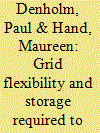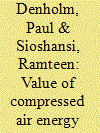|
|
|
Sort Order |
|
|
|
Items / Page
|
|
|
|
|
|
|
| Srl | Item |
| 1 |
ID:
112312


|
|
|
|
|
| Publication |
2012.
|
| Summary/Abstract |
Both renewable and nuclear energy can provide significant contributions to decarbonizing the electric sector. However, a grid employing large amounts of wind and solar energy requires the balance of the system to be highly flexible to respond to the increased variability of the net load. This makes deployment of conventional nuclear power challenging both due to the technical challenges of plant cycling and economic limits of reduced capacity factor. In the United States nuclear power plants generally provide constant, base load power and are most economic when operated at constant power levels. Operating nuclear power plants in load-following modes decreases the plants' annual energy output and increases the levelized cost of energy, decreasing economic competitiveness.
One possible solution is to couple thermal energy storage to nuclear power plants. This would enable the reactor to remain at nearly constant output, while cycling the electrical generator in response to the variability of the net load. This paper conceptually explores combinations of wind, solar, and nuclear that can provide a large fraction of a system's electricity, assuming the use of thermal energy storage that would allow nuclear power to provide load following and cycling duty while operating at a constant reactor power output.
|
|
|
|
|
|
|
|
|
|
|
|
|
|
|
|
| 2 |
ID:
103490


|
|
|
|
|
| Publication |
2011.
|
| Summary/Abstract |
We examine the changes to the electric power system required to incorporate high penetration of variable wind and solar electricity generation in a transmission constrained grid. Simulations were performed in the Texas, US (ERCOT) grid where different mixes of wind, solar photovoltaic and concentrating solar power meet up to 80% of the electric demand. The primary constraints on incorporation of these sources at large scale are the limited time coincidence of the resource with normal electricity demand, combined with the limited flexibility of thermal generators to reduce output. An additional constraint in the ERCOT system is the current inability to exchange power with neighboring grids.
By themselves, these constraints would result in unusable renewable generation and increased costs. But a highly flexible system - with must-run baseload generators virtually eliminated - allows for penetrations of up to about 50% variable generation with curtailment rates of less than 10%. For penetration levels up to 80% of the system's electricity demand, keeping curtailments to less than 10% requires a combination of load shifting and storage equal to about one day of average demand.
|
|
|
|
|
|
|
|
|
|
|
|
|
|
|
|
| 3 |
ID:
176664


|
|
|
|
|
| Summary/Abstract |
Concentrating solar power (CSP) integrated with thermal energy storage delivers flexible and dispatchable power, which is an increasingly valuable quality as electricity systems integrate growing penetrations of variable renewable energy. Valuing and compensating CSP's dispatchability and flexibility requires electricity market structures and policies that appropriately remunerate generation during high-value portions of the day. We review previous analyses of CSP economics and deployment, and we find that continued CSP growth will require valuation mechanisms that appropriately compensate for CSP's flexibility during both plant design and plant operation. We then review market structures that drive CSP operations and dispatch in jurisdictions where CSP is being developed, with perspectives from Spain, Chile, Australia, Morocco, South Africa, the United States, China, and the United Arab Emirates (Dubai). Despite broad agreement that CSP's dispatchability provides value to electricity grids, countries' policies for remunerating and leveraging such dispatchability varies widely. As deployment of CSP and variable renewable energy grows, it will be increasingly important to redesign current integration policies to signal the delivery of CSP's grid services more appropriately.
|
|
|
|
|
|
|
|
|
|
|
|
|
|
|
|
| 4 |
ID:
088987


|
|
|
|
|
| Publication |
2009.
|
| Summary/Abstract |
In this work, we examine the potential advantages of co-locating wind and energy storage to increase transmission utilization and decrease transmission costs. Co-location of wind and storage decreases transmission requirements, but also decreases the economic value of energy storage compared to locating energy storage at the load. This represents a tradeoff which we examine to estimate the transmission costs required to justify moving storage from load-sited to wind-sited in three different locations in the United States. We examined compressed air energy storage (CAES) in three "wind by wire" scenarios with a variety of transmission and CAES sizes relative to a given amount of wind. In the sites and years evaluated, the optimal amount of transmission ranges from 60% to 100% of the wind farm rating, with the optimal amount of CAES equal to 0-35% of the wind farm rating, depending heavily on wind resource, value of electricity in the local market, and the cost of natural gas.
|
|
|
|
|
|
|
|
|
|
|
|
|
|
|
|
|
|
|
|
|